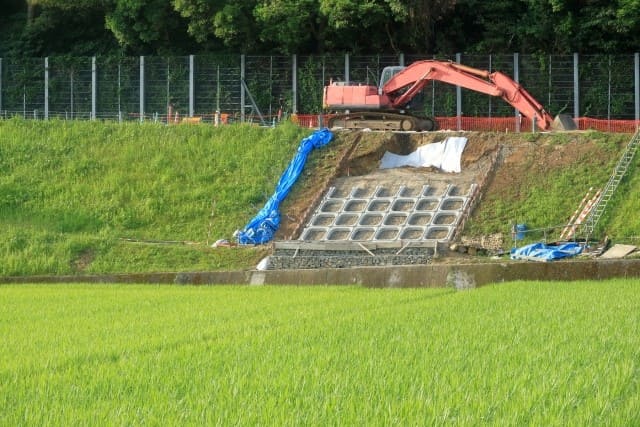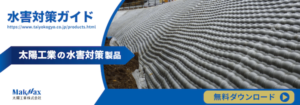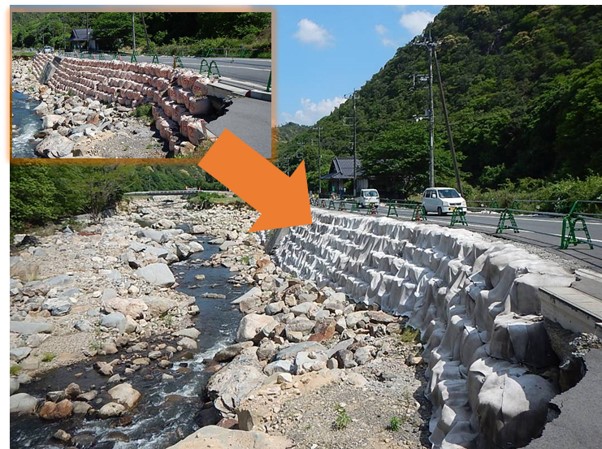

Taiyo Kogyo Column
Making Slope Protection Work More Affordable! Introducing Law Surface Protection Methods that Combine High Performance and Low Cost
2019.12.25

Slopes are always in the process of collapsing, and slope protection work is necessary to deter their collapse.
In this issue, we will introduce various types of slope construction and also introduce “Concrete Canvas,” a new innovation in slope construction.
Click here for theConcrete Canvas product page:
For inquiries about the product,click here.
Construction work related to slopes
There are three major types of construction work related to slopes
- Cut and fill construction
- slope drainage works
- slope protection works
(1) Cut and fill construction
Slope work is the process of removing unnecessary earth and sand from a slope and shaping it by filling it with soil. It can be said to be the most basic slope work to level a slope such as a mountain. However, even if this is the only way to form a slope, water flowing on the surface will erode it, or water will seep in and cause the slope to collapse.
(2) Slope drainage
Most slope failures are caused by surface water and groundwater. Installation of appropriate slope drainage ditches directs surface and groundwater to prevent erosion and collapse. In Japan, where the terrain is steep, precipitation is abundant, and the country is often hit by heavy rainfall such as typhoons and guerrilla rains, drainage, especially in civil engineering structures, is of great importance. Drainage works on slopes can be divided into two main categories: surface drainage and subsurface drainage.
(iii) Slope protection work
This work is designed to strengthen shaped slopes and prevent erosion. There are various methods for slope protection work, each with its own advantages and disadvantages. It is necessary to always consider and select the appropriate method for each situation.
See also:Download Slope Protection Resources
Slope protection work
Slope protection is particularly important among slope-related works. Slope protection work can be broadly classified into revegetation and structure-based work, and structure-based work can be broadly classified into the following four categories based on its purpose.
(1) Control of sediment runoff due to springs, etc.
Cages or fences are placed at the bottom of the slope to stop sediment runoff. The bottom of the slope is the underside of the slope. For example, when soil is piled up on top of the ground, the “bottom of the slope” is the break point at the junction of the ground and the fill.

Cages filled with natural stone can be classified as “cages,” “futon cages,” “cage mats,” etc., depending on the soil pressure on the structure. The type of cage depends on the earth pressure applied to the structure. Fence construction is often combined with vegetation.
Example of futon cage
(2) Prevention of surface weathering and erosion
Slope surfaces are covered with concrete or other materials to prevent erosion and weathering caused by surface water and other factors. Typical methods include mortar concrete spraying, stone lining, and block lining. Mortar concrete spraying is a method of spraying mortar concrete by compressed air using a spraying machine. As a general construction procedure, spraying is performed after fixing a diamond-shaped wire mesh called lath netting on the slope after cleaning, which is intended to prevent cracks and peeling of the concrete.
The mortar concrete to be sprayed is mixed at a plant yard on site and pumped through a delivery hose to the slope. Stone and concrete blocks are laid on the slope using cranes, backhoes, and jigs to cover the surface.
Sprayed, masonry, and block can all prevent water from seeping into the slope, but at the same time, water pressure from the back of the structure is applied to the structure, so drainage and drainage are provided to eliminate water from the back of the structure.
(iii) Prevention of surface collapse (earth retaining)
Retaining walls that can withstand earth pressure from behind prevent slopes from collapsing. Retaining walls can be installed to make slopes steeper and to accommodate site and topographical limitations.
Various methods, such as casting concrete retaining walls on-site, installing secondary product retaining walls, or building earth retaining structures with masonry or concrete block piles, are employed on slopes that would collapse if only the surface layer is protected.
(4) Prevention of collapse due to sliding of slopes
Due to moisture in the soil and the weight of the soil itself, slopes can “slip” from certain cross-sectional boundaries, causing the soil to collapse. To prevent collapse, anchors or other reinforcement are inserted into the slope. The depth at which the soil will slip is determined based on ground analysis and investigation, and ground anchors or reinforcement are inserted to a greater depth to hold the soil mass, including the slope. Anchors and reinforcement are covered with concrete or other materials so that they are not exposed on the slope surface. Often used in combination with slope construction, the anchors are connected to each other with reinforced concrete to reinforce the slope even more firmly.
While many of these methods have a long history and a proven track record, we would like to introduce “concrete canvas” as a new slope protection material that has been attracting attention in recent years.
Related information: Download Slope Protection Resources
Concrete Canvas, a new innovation in slope construction
Concrete Canvas ” is a composite material of concrete and canvas (fabric). When moisture is added to the cement-containing fabric, it hardens as concrete.

Features include workability, durability, and flexibility. First of all, concrete canvas is lightweight, weighing only about 70 kg per piece. Since it can be freely cut on site, it can be transported and installed by hand even in areas where heavy machinery cannot enter. The only sub-materials required for laying are anchor pins and screws for joining, and the only tools needed are a hammer and an impact wrench. And only water sprinkling is required for curing. Therefore, there is no need for plant installation or pouring equipment, and no need for specialized skills such as sprayers or formworkers.
The concrete canvas’s ease of installation makes it possible to construct concrete surfaces easily, anywhere, by anyone. Next is durability. Concrete Canvas has been tested to British Standards for weather resistance and is capable of withstanding outdoor environments for at least 50 years. The cement used in the canvas, when properly hydrated, develops a compressive strength of 40 MPa. This is a very superior value compared to the nominal strength of ordinary unreinforced concrete (18, 21, etc.).

Cutter cutting allows fine adjustment to suit the site
It has been tested for weather resistance, chemical resistance, water resistance, and fire resistance, making it an extremely tough material. Concrete canvas can contribute significantly to reducing post-construction maintenance costs. Finally, there is flexibility. Concrete canvas has the properties of a fabric until it begins to harden, making it flexible enough to follow the complex shapes of the ground. In addition, it can be cut with a cutter knife, allowing for fine adjustments to suit the site, and is used not only for slope protection, but also for various applications such as canal repair.
summary
Slope construction takes many forms, the most important of which is slope protection, but each method has its advantages and disadvantages. Concrete canvas is an example of this.

Concrete canvas can be easily used at low cost, and its durability reduces post-construction maintenance costs. We have already introduced various examples of concrete canvas in 47 prefectures in Japan, including local governments, so please visit our official website.
Related information:Download materials on slope protection
national land enterpriseへの
Contact us
Related Articles
- TOP>
- Taiyo Kogyo Column>
- Making Slope Protection Work More Affordable! Introducing Law Surface Protection Methods that Combine High Performance and Low Cost









